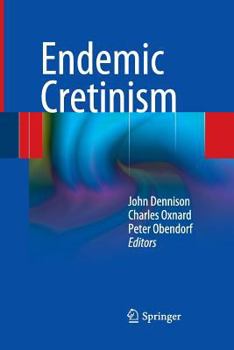Endemic Cretinism
Select Format
Select Condition 
Book Overview
Introduction
Chapters
I. Etymology of the word 'cretin' (Wegelin)
II. Definition (de Quervain)
III. Historical (Wegelin)
IV. Epidemiology (Wegelin)
1. Statistics
2. Geographical distribution
Europe
Asia
Australia
Africa
America
3. Racial affinity
4. Relation to endemic goitre
V. Course and clinical pattern of cretinism (de Quervain)
Cretinism with and without goitre
Grade of cretinism
Development of cretins
Deterioration
Spontaneous recovery
Influence of endemic goitre on children
1. The sexual distribution of cretinism
2. The behaviour of physical development
Growth in non-goitrous cretins
Growth in goitrous cretins
Development quotient
a) The individual parts of the skeleton
Behaviour of the skull
Cranial capacity
Dentition
Remainder of skeleton
Appearance of centres of ossification
Joints
Cretin hips
Humerus varus
Pelvis
b) The skin and its appendages
Myxoedema
Skin shade
Dryness of the skin
Hair growth
c) The musculature
d) The behaviour of the endocrine glands
The thyroid gland
Atrophy of the thyroid
Cretinous goitre
The parathyroid glands
The sexual glands and the sexual organs
Hypophysis
e) The intestinal tract and its glands
f) The blood vascular system
Heart
Capillary structure
g) The nervous system
Mobility
Neuromuscular system
Tendon reflexes
MacCarrison's 'Nervous cretinism'
Sense organs Hearing disorders
Speech disorders
Autonomic nervous system
3. The intellectual behaviour of cretins
Mental debility
Intellectual development
Acquisitive instinct
Imitative behaviour
Self-awareness
Emotions
Sociability
Gratitude
Sexual behaviour
Psychological functions in relation to body type
VI. Pathological anatomy and histology (Wegelin)
1. Thyroid gland
Epithelial changes
Sclerosis
Lymphocyte infiltration
Vascularization
Regenerative epithelial growth
Nodular goitre
Malignant epithelial goitr
Vascularisation of nodular goitre
Functional behaviour of the thyroid gland
Diffuse goitre
'Niduses' of squamous epithelium
Dispersed aggregations of parathyroid cells and remnants of
the ultimobranchial body
2. Parathyroid glands
3. Thymus
4. Hypophysis
5. Pineal gland
6. Suprarenal glands
7. Gonads
A. Male gonads
B. Female gonads
Ovaries
Uterus Breasts
8. Nervous system
Meninges
Brain
Spinal cord
Peripheral nerves
9. Musculature
10. The skeleton
General restriction in growth
Physical proportions
Development
Bone form relationships
Skull
Trunk
Upper limbs
Lower limbs
11. Joints
12. Teeth
13. Skin and subcutaneous tissue
14. Ear
15. Circulatory system Heart
Arteries
Capillaries
16. Blood, and blood-forming organs
Blood
Bone marrow
Lymph glands
Spleen
17. Respiratory organs
18. Digestive organs
Tongue
Stomach and intestine
Pancreas
Liver
Gall bladder
Peritoneum
19. Urinary system
20. Further anatomical findings
Malformations
Blastoma
Tuberculosis
Syphilis
21. Lifespan and diseases of cretins
Average age
Causes of death
22. Cretinism in animals
23. Summary
VII. Pathological physiology (de Quervain)
Endemic thyropathy
Metabolism
Albume
Chapters
I. Etymology of the word 'cretin' (Wegelin)
II. Definition (de Quervain)
III. Historical (Wegelin)
IV. Epidemiology (Wegelin)
1. Statistics
2. Geographical distribution
Europe
Asia
Australia
Africa
America
3. Racial affinity
4. Relation to endemic goitre
V. Course and clinical pattern of cretinism (de Quervain)
Cretinism with and without goitre
Grade of cretinism
Development of cretins
Deterioration
Spontaneous recovery
Influence of endemic goitre on children
1. The sexual distribution of cretinism
2. The behaviour of physical development
Growth in non-goitrous cretins
Growth in goitrous cretins
Development quotient
a) The individual parts of the skeleton
Behaviour of the skull
Cranial capacity
Dentition
Remainder of skeleton
Appearance of centres of ossification
Joints
Cretin hips
Humerus varus
Pelvis
b) The skin and its appendages
Myxoedema
Skin shade
Dryness of the skin
Hair growth
c) The musculature
d) The behaviour of the endocrine glands
The thyroid gland
Atrophy of the thyroid
Cretinous goitre
The parathyroid glands
The sexual glands and the sexual organs
Hypophysis
e) The intestinal tract and its glands
f) The blood vascular system
Heart
Capillary structure
g) The nervous system
Mobility
Neuromuscular system
Tendon reflexes
MacCarrison's 'Nervous cretinism'
Sense organs Hearing disorders
Speech disorders
Autonomic nervous system
3. The intellectual behaviour of cretins
Mental debility
Intellectual development
Acquisitive instinct
Imitative behaviour
Self-awareness
Emotions
Sociability
Gratitude
Sexual behaviour
Psychological functions in relation to body type
VI. Pathological anatomy and histology (Wegelin)
1. Thyroid gland
Epithelial changes
Sclerosis
Lymphocyte infiltration
Vascularization
Regenerative epithelial growth
Nodular goitre
Malignant epithelial goitr
Vascularisation of nodular goitre
Functional behaviour of the thyroid gland
Diffuse goitre
'Niduses' of squamous epithelium
Dispersed aggregations of parathyroid cells and remnants of
the ultimobranchial body
2. Parathyroid glands
3. Thymus
4. Hypophysis
5. Pineal gland
6. Suprarenal glands
7. Gonads
A. Male gonads
B. Female gonads
Ovaries
Uterus Breasts
8. Nervous system
Meninges
Brain
Spinal cord
Peripheral nerves
9. Musculature
10. The skeleton
General restriction in growth
Physical proportions
Development
Bone form relationships
Skull
Trunk
Upper limbs
Lower limbs
11. Joints
12. Teeth
13. Skin and subcutaneous tissue
14. Ear
15. Circulatory system Heart
Arteries
Capillaries
16. Blood, and blood-forming organs
Blood
Bone marrow
Lymph glands
Spleen
17. Respiratory organs
18. Digestive organs
Tongue
Stomach and intestine
Pancreas
Liver
Gall bladder
Peritoneum
19. Urinary system
20. Further anatomical findings
Malformations
Blastoma
Tuberculosis
Syphilis
21. Lifespan and diseases of cretins
Average age
Causes of death
22. Cretinism in animals
23. Summary
VII. Pathological physiology (de Quervain)
Endemic thyropathy
Metabolism
Albume
Format:Paperback
Language:English
ISBN:1489997822
ISBN13:9781489997821
Release Date:October 2014
Publisher:Springer
Length:215 Pages
Weight:0.73 lbs.
Dimensions:0.5" x 6.1" x 9.2"
Customer Reviews
0 rating





